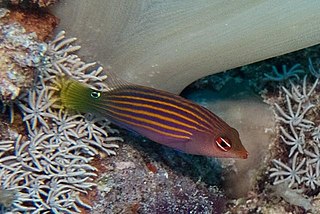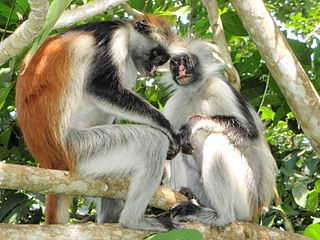Related Research Articles

Zanzibar is an insular semi-autonomous region which united with Tanganyika in 1964 to form the United Republic of Tanzania. It is an archipelago in the Indian Ocean, 25–50 km (16–31 mi) off the coast of the African mainland, and consists of many small islands and two large ones: Unguja and Pemba Island. The capital is Zanzibar City, located on the island of Unguja. Its historic centre, Stone Town, is a World Heritage Site.

Pemba Island is a Tanzanian island forming part of the Zanzibar Archipelago, lying within the Swahili Coast in the Indian Ocean.

Chumbe Island is a private island in the Mjini Magharibi Region, Tanzania, off the coast of Mjini District. It is situated in the Zanzibar Channel. The island is known for its ecological innovation and exceptional coral reefs. The Chumbe Lighthouse is also located on the island.

The potato grouper, also called the potato cod or potato bass, is a species of marine ray-finned fish, a grouper from the subfamily Epinephelinae which is part of the family Serranidae, which also includes the anthias and sea basses. It has a wide Indo-Pacific distribution.

The six-line wrasse is a species of marine ray-finned fish from the family Labridae which has a wide Indo-Pacific distribution. This species is associated with coral reefs and can be found in the aquarium trade.

Tumbatu is historic Swahili settlement located on Tumbatu Island, Kaskazini A District of Unguja North Region in Tanzania. This site is a significant archaeological site that contains a large number of collapsed coral stone structures including private houses and several mosques, the largest of which is located on the shore facing the village of Mkokotoni on Unguja. Pearce initially looked into the ruins in 1915 and wrote about the mosques, palace, and other stone homes.

Melicerona felina, common name the kitten cowrie, is a species of sea snail, a cowry, a marine gastropod mollusk in the family Cypraeidae, the cowries.

Naria lamarckii, common name the Lamarck's cowrie, is a species of sea snail, a cowry, a marine gastropod mollusk in the family Cypraeidae, the cowries.

The wildlife of Zanzibar consists of terrestrial and marine flora and fauna in the archipelago of Zanzibar, an autonomous region of Tanzania. Its floral vegetation is categorized among the coastal forests of eastern Africa as the Southern Zanzibar-Inhambane coastal forest mosaic and the Northern Zanzibar-Inhambane coastal forest mosaic. Its faunal species are mostly small animals, birds, and butterflies.

The Chumbe Marine Park, officially recognized officially as Chumbe Reef Sanctuary is a privately managed marine park on Chumbe Island, Zanzibar since 1994. It is successful as an ecotourism project. The objective of this sanctuary is to preserve and develop the rich biodiversity of the coral. Set up after controversial debate over a period of 3 years between the private developer of the park, the government and the local fishermen, the sanctuary has received funds from European Union, Gesellschaft für Technische Zusammenarbeit and many other donors including the initial developer.
Mnemba Island is a single small island located about 3 km off the northeast coast of Unguja, the largest island of the Zanzibar Archipelago, Tanzania, opposite Muyuni Beach. It is roughly triangular in shape, about 500 metres (1,640 ft) in diameter and about 1.5 kilometres (0.9 mi) in circumference. It is surrounded by an oval reef seven by four kilometres in extent. These reefs have been declared a marine conservation area. Mnemba Island and its reef are sometimes called Mnemba Atoll which is incorrect because an atoll is an island that encircles a lagoon, which is not the case for Mnemba Island.

Gnathia marleyi is a species of crustacean in the family Gnathiidae. It is named after reggae musician Bob Marley. It is a parasite that infests and feeds on the blood of such fish as the French grunt. This tiny species is only found in the Caribbean Sea. It only eats while in the juvenile stage. It can be found hiding among sea sponges, algae, and pieces of dead coral.

Epinephelus spilotoceps, the foursaddle grouper or spotty cod, is a species of marine ray-finned fish, a grouper from the subfamily Epinephelinae which is part of the family Serranidae, which also includes the anthias and sea basses. It is found in the Indo-Pacific region.

The Barrier Reef chromis, also known as the yellowback puller or shining puller, is a species of damselfish in the family Pomacentridae native to the east coast of Australia. It is a small fish with a yellowish-brown dorsal surface separated by a dark stripe from its silvery flanks and underside.

Cirolana cranchii is a species of isopod crustacean.

Cirolana is a genus of isopod crustaceans.
Cyril Crossland was an English zoologist.

Chaetodon zanzibarensis, the Zanzibar butterflyfish, is a species of marine ray-finned fish, a butterflyfish belonging to the family Chaetodontidae. It has a wide distribution throughout the western Indian Ocean stretching from the eastern coast of Africa to Madagascar, the Seychelles, Réunion and Mauritius. Its named after the Tanzanian island of Zanzibar

The Mafia Archipelago or The Mafia Islands is an group of islands across the Mafia Channel in the Mafia District of Pwani Region's coast on the Sea of Zanj in Tanzania's Indian Ocean coast. The archipelago is composed of 9 islands and around 12 coral reefs. In total, the Mafia archipelago covers 972 km2 (375 sq mi) in total, of which 8.5 km2 (3.3 sq mi) 407 km2 are land and 565 km2 are water. and has an average elevation of 53 m (174 ft). Of the 12 reefs in the archipelago the most famous one is the Tutia Reef. The nine Islands in the archipelago are. The largest island in the archipelago is Mafia Island also known as Chole Shamba locally. The other eight islands inside Mafia District in addition to Mafia Island are; Juani Island, Chole Island, Jibondo Island (Kibondo), Bwejuu Island, Shungumbili Island (Thanda), Barakuni Island, Miewi Island, and Niororo Island (Nyororo).
Tutia Reef is a system of protected coral reefs inside the Mafia Island Marine Park (MIMP) with the IUCN category II designation. The reef is located on Tanzania's Mafia Archipelago of Mafia District in southern Pwani Region of Tanzania. Tutia Reef is rated as the country's top spot for sport fishing, however the reef is also the site some of the worst coral bleaching events in history in 1998. The reef is located south west of Jibondo Island inside the Mafia Channel.
References
- 1 2 Niel L. Bruce (2004). "Cirolana mercuryi sp. nov., a distinctive cirolanid isopod (Flabellifera) from the corals reefs of Zanzibar, East Africa". Crustaceana . 76 (9): 1071–1081. doi:10.1163/156854003322753420. S2CID 86086908.
- ↑ Mark Isaak (2008-12-29). "Curiosities of Biological Nomenclature".